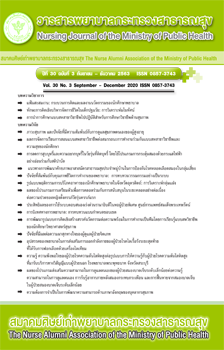Nursing Supervision: A Scoping Review
Main Article Content
Abstract
A scoping review was used to review 6 aspects of nursing supervision in Thailand: 1) the supervision model, 2) the supervision results, 3) the supervisors, 4) the supervision methods, 5) the places of supervision, and 6) the problems and obstacles associated with the supervision. Studies from the database of online journals in the THAIJO system, published from January 2010 to January 2020, found that there were 14 research papers that met the criteria for inclusion. Data were analyzed using frequency and content analysis. The results showed that: 1) nursing supervision can be divided into 2 types which were nursing supervision and clinical supervision; 2). the results of the nursing supervision were found as the results of the supervisors, supervisees, and clients; 3) supervisors could be divided into 2 levels, which are hospital supervisors and department supervisors; 4) there were 3 types of supervision methods; group supervision, individual supervision, and a blend of group and individual supervision; 5) the places of supervision consisted of the specialized institutions, central hospitals, general hospitals, and hospitals under the Ministry of Defense. Most of them were conducted in the wards; 6) there were 5 aspects of problems and obstacles in supervision: 1) policy, 2) supervisors, 3) supervision process, 4) supervisees, and 5) supporting tools and equipment. Further research should be conducted on nursing supervision in small hospitals such as Tambon Health Promoting Hospitals, or in community nursing. Nursing supervision should be developed into other models, such as online nursing supervision or other forms, in order to gain comprehensive and useful knowledge for the future.
Article Details
บทความและรายงานวิจัยในวารสารพยาบาลกระทรวงสาธารณสุข เป็นความคิดเห็นของ ผู้เขียน มิใช่ของคณะผู้จัดทำ และมิใช่ความรับผิดชอบของสมาคมศิษย์เก่าพยาบาลกระทรวงสาธารณสุข ซึ่งสามารถนำไปอ้างอิงได้
References
2. Thailand Nursing and Midwifery Council. Announcement of the nursing council on nursing and midwifery services in primary care. (2005, 4 August). Government Gazette. Book 122, Chapter 62 D, 63-70. (in Thai)
3. Pollock A, Campbell P, Deery R, Fleming M, Rankin J, Sloan G, et al. A systematic review of evidence relating to clinical supervision for nurses, midwives and allied health professionals. Journal of Advanced Nursing 2017;73(8):1825-37.
4. Ruiz-Perez I, Petrova D. Scoping reviews: another way of literature review. Med Clin (Barc) 2019;153(4):165-8.
5. Arksey H, O’Malley L. Scoping studies: towards a methodological framework. International Journal of Social Research Methodology 2005;8(1):19-32.
6. Maungprasert S, Kongkakul U, Sahmaae N, Kuiburd T, Iemwuttiwattana J, haroenwong S. The development of participative clinical supervision model among the nursing division in Naradhiwas Rajanagarindra Hospital. Princess of Naradhiwas University Journal 2018;10(2):13-24. (in Thai)
7. Wanthanatas R, Sritragool R, Dapha S, Changming A, Learahabumrung P, Naklamai A. Development of a nursing clinical supervision model for high alert drugs (HADs) administration with nurse supervisors’ participation in Nakhon Pathom Hospital. Journal of Nursing and Health Care 2018;36(1):234-43. (in Thai)
8. Sawasdee R, Moolsart S. The development of the clinical supervision model of head nurses at general hospital in regional health 2. Buddhachinaraj Medical Journal 2019;36(2):197-210. (in Thai)
9. Kutragoo R, Chantara P, Yimyam P, Khumpakum S, Namjuntra R. The development of a clinical supervision model for severe sepsis patients. Thai Journal of Cardio-Throracic Nursing 2019;30(2):193-209. (in Thai)
10. Limtrakul D. Developing a nursing supervision model of anesthetist nurse division for standardize and quality of service. Hua Hin Sook Jai Klai Kangwon Journal 2019;4(1):77-90. (in Thai)
11. Toncumprewat M, Boonyanurak P, Wangsukpisan A. Effects of safety nursing supervision model on perception of nursing advocacy among professional nurses. Journal of Police Nurses 2017;9(2):186-94. (in Thai)
12. Chumpinij N, Moolsart S. The development of a clinical supervision model for head nurses at Bhumibol Adulyadej Hospital. Journal of The Police Nurse 2015;7(2):77-89 (in Thai)
13. Intasuwan A, Chantra R, Sarakshetrin A. The effective of nursing supervision model in the nursing organization of Ranong Hospital. Journal of Nursing Division 2016;43(3):25-43. (in Thai)
14. Tantiveas M, Khumyu A, Otakanon P. The development of nursing supervisory model for unofficial-time nursing supervisors, Prest’s Hospital. Journal of Faculty of Nursing Burapha University 2017;25(3):41-51. (in Thai)
15. Supunpayab P, Sukadisai P, Amphon K. Developing a nursing supervision model of the Nursing Division in Phrapokklao Hospital. Journal of Nursing and education 2013;6(1):12-26. (in Thai)
16. Swatdiwong P, Von Bormann S. Relationship between head nurse’s supervision style and registered nurse’s care for patient safety in tertiary hospitals in Nonthaburi. Nursing Journal 2019;46(4):158-72. (in Thai)
17. Kamnoetkiattisak S, Anusanti S, Sirilukkhananun K. The effect of using the nursing supervision model integrated with critical thinking conception perceived reasoning ability in nursing practice of professional nurse. Vajira Nursing Journal 2019;21(1):18-33. (in Thai)
18. Sapyen K, Jaturongkachock K, Tantiwarasakool K. The development of clinical nursing supervision model for prevention of pressure injury in Banpong Hospital. Region 4-5 Medical Journal 2019;38(4):300-17. (in Thai)
19. Homnan N, Wisesrith W. The development of preventive emergency obstetric clinical supervision model for nurses. Journal of The Royal Thai Army Nurses 2017;18(Supplement): 140-8. (in Thai)
20. Proctor B. Training for the supervision alliance attitude, skill and intention. In Fundamental themes in clinical supervision. Cutcliffe, J.R, Butterworth, T., and Proctor, B., eds. London: Routledge, 2001.
21. Gershon RR, et al. Healthcare workers experience with post-exposure management of bloodborne pathogen exposures: a pilot study. American Journal of Infection Control 2000;28:421-8.
22. Kittiratchada S, Wanichpunchaphol W. Nursing supervision implementation to quality. Bangkok: wvothai printing, 2008. (in Thai)
23. Fayol, H. General and industrial management. London: Sir Isaac Pitman & Sons, 1949.
24. Fonteyn ME. Thinking strategies for nursing practice. New York: Lippincott, 1998.
25. Alexander G, Alar F, More JW. GROW-Model Coaching [internet]. 2010 [cited 2010 Sep 4]. Available from:https://en.wikipedia.org/GROW-Model.
25. Hawkins P, Shohet R. Supervision in the helping professions (supervision in context). 4th ed. Maidenhead: Open University Press;2012.
26. Chandra-ambhorn S. Factors related to participation in nursing service quality improvement of professional nurses, Phramongkutklao Hospital. EAU heritage 2012;6(1):140-9. (in Thai)

